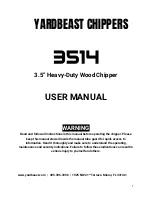
24
Mounted Legs and Lifting (15 – 40 ton
Units)
The unit ships on its side with the legs removed to
reduce shipping dimensions and provide more
protection to the coil from possible damaged caused
by impact loading over rough roads and transit
conditions. Follow the below for mounting of the
legs and lifting into position.
Use only qualified persons using the proper
equipment when lifting and positioning the
condenser. Lifting brackets or holes are at the
corners for attaching lifting slings. Use spreader bars
when lifting to apply the lifting force vertically.
Interconnecting Refrigerant Piping
The chiller and remote condenser ship with a
nitrogen holding charge. Evacuation of this charge is
required before charging with refrigerant. The chiller
is for use only with the air-cooled condenser
provided with the unit. The following section covers
the required piping between the chiller and the
provided air-cooled condenser.
The discharge and liquid lines leaving the chiller
have caps. These line sizes do not necessarily reflect
the actual line sizes required for the piping between
the chiller and the air-cooled condenser. The
installing contractor need only provide the
interconnecting piping between the chiller and the
air-cooled condenser.
Refrigerant piping size and piping design have a
significant effect on system performance and
reliability. Refer to the Refrigeration Line Sizing
section of this manual to ensure the refrigerant
piping and runs are proper. All piping should
conform to the applicable local and state codes.
CAUTION: Use refrigerant grade copper tubing
ASTM B280 only and isolate the refrigeration
lines from building structures to prevent transfer
of vibration. All copper tubing must have a
pressure rating suitable for R-410A: tubing that
is ¾” OD or larger must be Type K rigid tubing.
ACR annealed tubing coil may be used for sizes
⅝” ODS or smaller.
Do not use a saw to remove end caps. This might
allow copper chips to contaminate the system. Use a
tube cutter or heat to remove the caps. When
sweating copper joints it is important to evacuate all
refrigerant present if any and flow dry nitrogen
through the system. This prevents the formation of
toxic gases, corrosive acids, and the formation of
scale within the copper tube.
CAUTION: Do not use soft solders. For copper-to-
copper joints use a copper-phosphorus braze
alloy (BCuP per the American Welding Society)
with 5% (BCuP-3) to 15% (BCuP-5) silver
content. Only use a high silver content brazing
alloy (BAg per AWS) for copper-to-brass or
copper-to-steel joints such as a 45% (BAg-5)
silver content. Only use oxy-acetylene brazing.
WARNING: The POE oil contained within the
compressor is hygroscopic and has the ability to
absorb water vapor from the atmosphere. Take
necessary steps to prevent an open system from
exposure to the atmosphere for extended periods
while installing the interconnecting refrigerant
tubing.
Refrigeration Piping Design
The system is configurable in any of the
arrangements as shown in Figure 32, Figure 33, and
Figure 34. The configuration and its associated
elevation, along with the total distance between the
chiller and the air-cooled condenser are important
factors in determining the liquid line and discharge
line sizes. This will also affect the field refrigerant
charges. Consequently, it is important to adhere to
















































